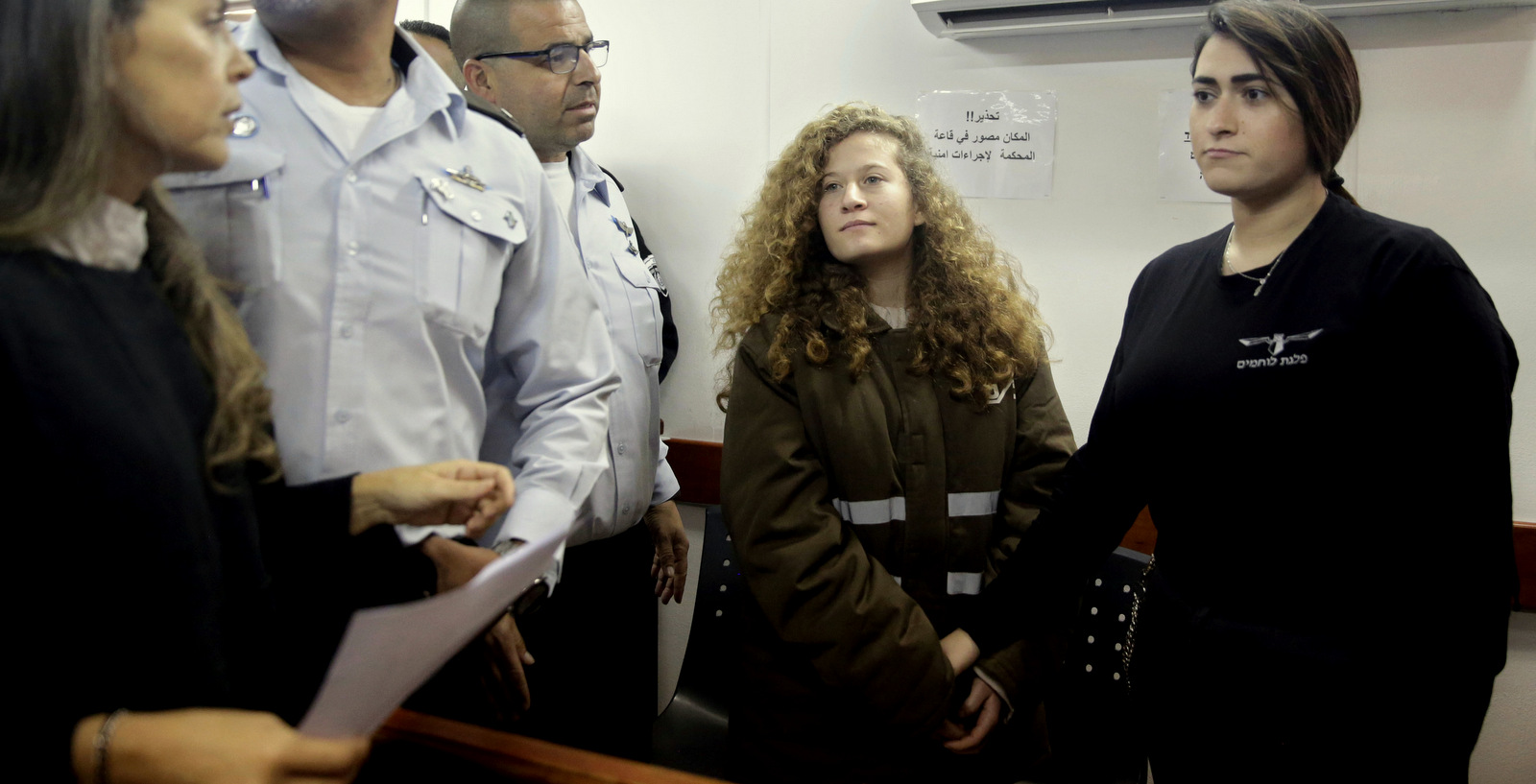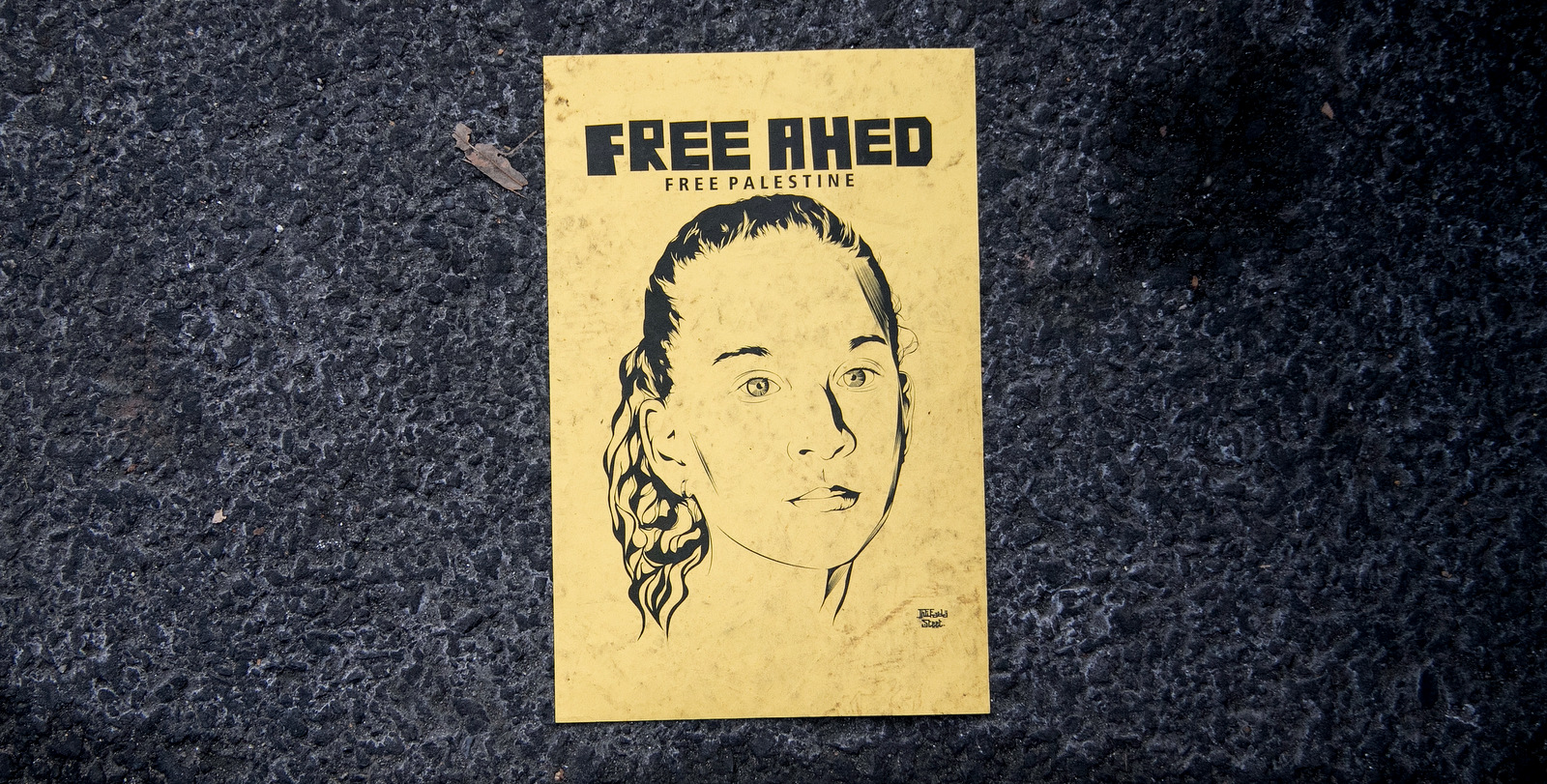In December 2017, a then 16-year-old Palestinian girl named Ahed Tamimi was filmed slapping and kicking an Israeli soldier outside her family home in the occupied West Bank. She had just heard that her 14-year-old cousin Muhammad had been shot in the head with a rubber bullet.
Tamimi then faced up to 10 years in prison on charges of assault and throwing stones. Last week she accepted a plea deal of eight months in prison (including four months already served). She is reportedly expected to plead guilty to four assault, incitement and obstruction charges.
The video of the incident went viral and was widely reported; Tamimi has been compared to Rosa Parks and Joan of Arc, among other heroic figures. But while the confrontation has provoked much debate, little appears to have changed in the region, where Tamimi is yet another child detainee. The latest published statistics, from November 2017, show Israel was holding more than 300 Palestinian minors in prison.
Though narrative victories can be as important as battlefield military gains in today’s conflicts, which are increasingly fought online and via social media as well. Tamimi’s story and her now iconic image has significant potential to influence opinions and positions on the ongoing occupation of Palestine.
‘Narrative victories can be as important as battlefield military gains in today’s conflicts.’
The potential influence of individual civilians, particularly girls and young women, in contemporary conflicts is a core theme in the recently-published book War in 140 Characters: How Social Media is Reshaping Conflict in the Twenty-First Century, by David Patrikarakos. It opens with a story that is strikingly similar to Tamimi’s case.
Related
- Rosario Dawson, Angela Davis, Cornel West Among 27 US Figures Calling for Release of Ahed Tamimi
- Israeli Military Court Delays Trial of Ahed Tamimi
- Ahed Tamimi Speaks of Her Struggle: “All I Wish Is for Palestine to Be Free”
- Ahed Tamimi Offers Israelis a Lesson Worthy of Gandhi
Patrikarakos’s first chapter is about another 16-year-old Palestinian girl, Farah Baker. She also became a global icon of resistance through social media, during the 2014 ‘Operation Protective Edge’ conflict in which the Gaza strip came under heavy bombardment. On Twitter, Baker’s followers grew from around 800 to more than 150,000 as she filmed the chaos from her balcony.
“She was a child, she was female, and a civilian. She was a civilian being bombed. She should have been the most powerless person, in a deeply patriarchal society,” Patrikarakos told me in a recent interview. But instead Baker drew global attention at a turning point in the Israel-Palestine conflict.
Patrikarokas argues in his book that while Israel won militarily in 2014, they lost the global information war: “In a major way, Operation Protective Edge inverted war’s traditional paradigm: it was an information war played out on the battlefield, in which the former was, at times, more important than the latter.”
It’s impossible to quantify the influence of Baker’s following and story on this narrative victory. But Patrikarakos sees her sudden social media fame as indicative of a new era in which “a lone teenage girl can now battle, and threaten, the institutional power of one of the world’s most powerful armies.”
“A lone teenage girl can now battle, and threaten, the institutional power of one of the world’s most powerful armies.”Patrikarakos calls this new kind of empowered, networked individual ‘homo digitalis’. The shift between hierarchical to networked power in contemporary warfare didn’t start with Tamimi, or Baker, and such observations have been made before.
Indeed, Patrikarakos draws on the 1999 book ‘New and old wars: organised violence in a global era’ by Mary Kaldor, who distinguishes between ‘old wars’ between states in which “battle is the decisive encounter” and ‘new wars’ that involve “networks of state and non-state actors.”
Operation Protective Edge, however, was one of the first wars to be documented mainly by amateurs on social media platforms. Since then, citizen journalists have become the often sole source of news in the Syrian civil war, accompanied by raging, complex disputes over credibility, authenticity and bias.
Amid these debates, and talk about ‘fake news,’ would Baker’s story find the same audience today? Her appeal in 2014 leaned heavily on her presentation as a ‘normal girl’ caught up in a situation beyond her control. Her tweets often emphasised the innocence of children. “BOMBING CHILDREN IS NOT OKAY. That’s when you know that HUMANITY DIED,” one read.
“BOMBING CHILDREN IS NOT OKAY. That’s when you know that HUMANITY DIED.”
As Patrikarakos points out, it’s notable that Baker was named by Foreign Policy magazine as an influential ‘chronicler’, not an activist.
Tamimi’s identity, on the other hand, is overtly political. Her family is renowned for documenting confrontations and abuses in their village of Nabi Saleh as well as for organising and protesting publicly.
Tamimi’s own history of activism has drawn global attention; she was invited to have breakfast with Turkey’s Prime Minister, for example, after she was filmed in 2012 shoving and shouting at soldiers twice her size.
Significantly, both Baker and Tamimi managed to reach beyond the demographic who regularly follow events related to the Israel-Palestine conflict. How did this happen?
“This is an age that prizes authenticity above all else,” Patrikarakos told me. This might help explain why a child is more likely to be believed than an adult who understands the power of lies online, though his book also highlights a gendered dimension to this issue.
Tamimi and Baker both managed to communicate a sense of raw, righteous anger to their followers and the general public. This can be seen as related to a child’s pure sense of right and wrong. But are we also more likely to identify and sympathise with girls, who “could be your sister,” or “your daughter”?

Ahed Tamimi is brought to a courtroom inside the Ofer military prison near occupied Jerusalem, Jan. 15, 2018. (AP/Mahmoud Illean)
Patrikarakos noted another similarity between Baker and Tamimi; the former he said “has blue eyes and very pale skin. And Tamimi is blonde. And I think actually, unfortunately, this plays a big part because they’re much more Western-friendly.” He added that Baker once told him that many people tweeted at her saying things like: “You’ve got blue eyes, how can you be a Palestinian?”
Tamimi’s appearance, with her long curly blonde hair (rare for Palestinians), has been particularly contentious. Some Israeli voices have alleged that the slapping incident was a manufactured performance for a global audience, to discredit Israel. She was dubbed “Shirley Temper,” and a formal investigation was even opened into the claim that her family were a troupe of actors.
But the accusation that the incident was purposefully filmed to influence a global audience, and therefore must be duplicitous or ‘fake’, is in itself a bizarre leap of logic. Tamimi’s family appears to be more than aware that physical confrontation and global content distribution are two sides of the same war. Isn’t this what an act of resistance looks like in the media age?
Israeli voices will no doubt continue to try and discredit Tamimi and her family on grounds that they are peddlers of ‘fake news,’ fully aware of the damage that an authentic, personal story of suffering can do. In Patrikarakos’s book, one official says: “There is nothing that a government spokesman can tweet or post to combat the image of a dead baby.”
Patrikarakos argues that Israel will always be at a disadvantage when it comes to the information war. Social media is an inherently emotional medium, favouring the sensational along with the horrific. To put it crassly: the suffering of the innocent gets clicks, and Israel inflicts far more civilian casualties.
At the same time, Israel can’t afford to lose its hold on the stories we hear and share. “Israel is a huge weapons producer, militarily really powerful, but still a small country,” Patrikarakos told me. “It still essentially needs permission to fight wars. They need the backing of powerful states like the US. They need to win the war at the discursive level.”
Tamimi has been hailed in Palestine as “worth a thousand men” – despite the fact that there is no clear binary in the Israel-Palestine conflict between male combatants and female non-combatants, or between ‘military’ and ‘civilian.’
Perhaps Tamimi’s gender does strengthen her power and influence in the global information war. But focusing on her role as a symbol, or a ‘tool,’ in this conflict can make it easy to lose sight of her humanity as a young person whose own life and future is at stake.
Personal stories of children and women have always played a prominent role in wartime propaganda. What’s changed is that now girls like Tamimi and Baker appear to have a higher degree of agency over how their stories are told.
And, as Patrikarakos pointed out: “Palestinians can never defeat Israel militarily. Now they have a chance of actually defeating them in the information sphere to the degree that it affects the military sphere.”
Top Photo | A Free Ahed Tamimi” flyer at 2018 Women’s March on January 20, 2018 in New York City. (Diego Corredor/MediaPunch/IPX)
Niki Seth-Smith is a freelance journalist, editor and fiction writer, published in Al Jazeera UK, VICE UK, the London Review of Books, the London Magazine, the New Humanist and others. At openDemocracy she has been Editor at OurKingdom (now oD UK), OurBeeb, and 50.50 (Interim Editor Jan-March 2017) and has co-edited two books: ‘Democratic Wealth: Building a Citizens’ Economy‘ and ‘Re-thinking the BBC: Public Media in the 21st Century‘. She lives in Athens, and is writing a novel.
![]() openDemocracy is licensed under a Creative Commons Attribution-NonCommercial-ShareAlike 4.0 International License.
openDemocracy is licensed under a Creative Commons Attribution-NonCommercial-ShareAlike 4.0 International License.
The post Ahed Tamimi Showed Us How Social Media Can Influence Wars appeared first on MintPress News.
